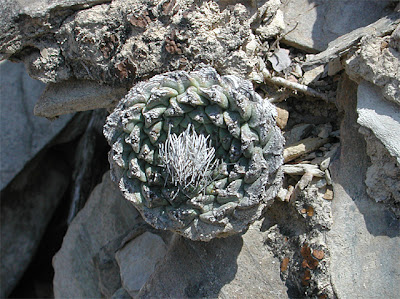The previous post featured habitat photos by Kauderwelsch who, in the meantime, has been kind enough to share more pictures at Wikimedia Commons. I’ve included a handful of his photos below.
The epidermis of this peyote cactus (Lophophora williamsii) is slightly bruised and looks like some animal nibbled on it but changed its mind after tasting the first couple of bitter bites (or maybe the bruises are just damage from the rocks scattered around the plant, but I like the “nibbling explanation” better ;-)

Peyote (Lophophora williamsii), near Monterrey, Nuevo León, México
Previously I haven’t been much into Mammillaria but seeing this magnificent picture of a flowering M. kraehenbuehlii has me wondering if I should grow some of these beautiful plants.

Flowering Mammillaria kraehenbuehlii
The next picture shows a Strombocactus disciformis growing in its typical habitat; nearly vertical, flaking limestone cliffs. It seems almost surreal that any plant is able to grow in this harsh biotope, but Strombocactus, Aztekium ritteri, and other species of cactus thrive in such conditions.
Strombocactus disciformis, near Vizarrón, Querétaro, México
The next two photos are a bit out of context (they are certainly not showing “small Mexican species”; and one is not even picturing a cactus ;-) I just fell for the beauty of the band of Cephalocereus columna-trajani standing tall against the background of towering clouds, and the sprawl of branches on that ancient looking Beaucarnea gracilis.

Cephalocereus columna-trajani,(syn. C. hoppenstedtii), near Tehuacán, Puebla, México

Adult specimen of Beaucarnea gracilis, Zapotitlán Salinas, Oaxaca, México
I have to visit México!
The photos are published under the terms of the GNU Free Documentation License. The original high resolution copies of the pictures are available here:
- Lophophora williamsii, near Monterrey, Nuevo León, México
- Flowering Mammillaria kraehenbuehlii
- Strombocactus disciformis, near Vizarrón, Querétaro, México
- Cephalocereus columna-trajani (syn. C. hoppenstedtii), near Tehuacán, Puebla, México
- Adult specimen of Beaucarnea gracilis, Zapotitlán Salinas, Oaxaca, México



















